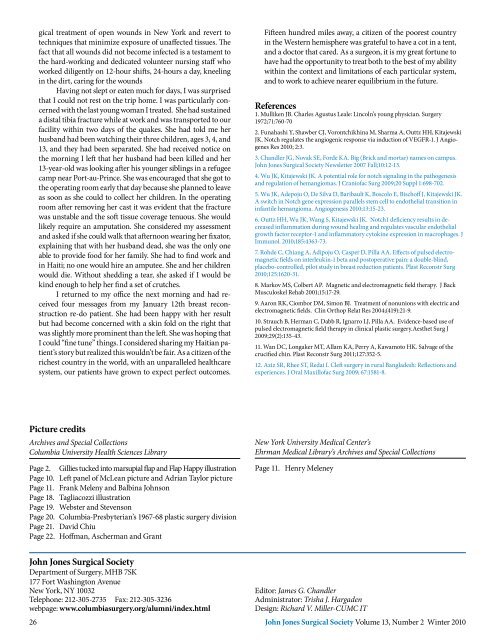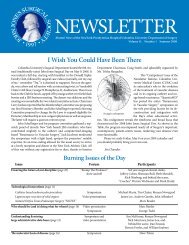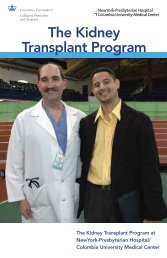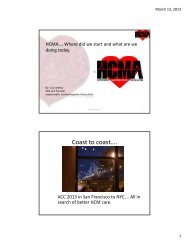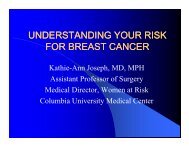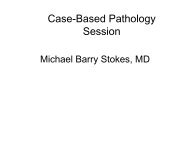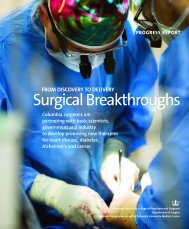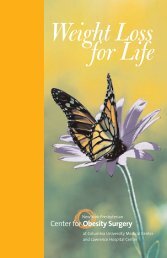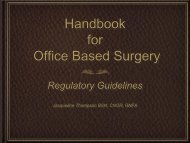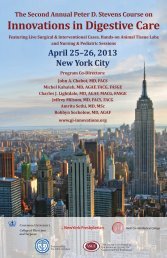NEWSLETTER - Columbia University Department of Surgery
NEWSLETTER - Columbia University Department of Surgery
NEWSLETTER - Columbia University Department of Surgery
You also want an ePaper? Increase the reach of your titles
YUMPU automatically turns print PDFs into web optimized ePapers that Google loves.
gical treatment <strong>of</strong> open wounds in New York and revert to<br />
techniques that minimize exposure <strong>of</strong> unaffected tissues. The<br />
fact that all wounds did not become infected is a testament to<br />
the hard-working and dedicated volunteer nursing staff who<br />
worked diligently on 12-hour shifts, 24-hours a day, kneeling<br />
in the dirt, caring for the wounds<br />
Having not slept or eaten much for days, I was surprised<br />
that I could not rest on the trip home. I was particularly concerned<br />
with the last young woman I treated. She had sustained<br />
a distal tibia fracture while at work and was transported to our<br />
facility within two days <strong>of</strong> the quakes. She had told me her<br />
husband had been watching their three children, ages 3, 4, and<br />
13, and they had been separated. She had received notice on<br />
the morning I left that her husband had been killed and her<br />
13-year-old was looking after his younger siblings in a refugee<br />
camp near Port-au-Prince. She was encouraged that she got to<br />
the operating room early that day because she planned to leave<br />
as soon as she could to collect her children. In the operating<br />
room after removing her cast it was evident that the fracture<br />
was unstable and the s<strong>of</strong>t tissue coverage tenuous. She would<br />
likely require an amputation. She considered my assessment<br />
and asked if she could walk that afternoon wearing her fixator,<br />
explaining that with her husband dead, she was the only one<br />
able to provide food for her family. She had to find work and<br />
in Haiti; no one would hire an amputee. She and her children<br />
would die. Without shedding a tear, she asked if I would be<br />
kind enough to help her find a set <strong>of</strong> crutches.<br />
I returned to my <strong>of</strong>fice the next morning and had received<br />
four messages from my January 12th breast reconstruction<br />
re-do patient. She had been happy with her result<br />
but had become concerned with a skin fold on the right that<br />
was slightly more prominent than the left. She was hoping that<br />
I could “fine tune” things. I considered sharing my Haitian patient’s<br />
story but realized this wouldn’t be fair. As a citizen <strong>of</strong> the<br />
richest country in the world, with an unparalleled healthcare<br />
system, our patients have grown to expect perfect outcomes.<br />
Picture credits<br />
Archives and Special Collections<br />
<strong>Columbia</strong> <strong>University</strong> Health Sciences Library<br />
Page 2. Gillies tucked into marsupial flap and Flap Happy illustration<br />
Page 10. Left panel <strong>of</strong> McLean picture and Adrian Taylor picture<br />
Page 11. Frank Meleny and Balbina Johnson<br />
Page 18. Tagliacozzi illustration<br />
Page 19. Webster and Stevenson<br />
Page 20. <strong>Columbia</strong>-Presbyterian’s 1967-68 plastic surgery division<br />
Page 21. David Chiu<br />
Page 22. H<strong>of</strong>fman, Ascherman and Grant<br />
John Jones Surgical Society<br />
<strong>Department</strong> <strong>of</strong> <strong>Surgery</strong>, MHB 7SK<br />
177 Fort Washington Avenue<br />
New York, NY 10032<br />
Telephone: 212-305-2735 Fax: 212-305-3236<br />
webpage: www.columbiasurgery.org/alumni/index.html<br />
Fifteen hundred miles away, a citizen <strong>of</strong> the poorest country<br />
in the Western hemisphere was grateful to have a cot in a tent,<br />
and a doctor that cared. As a surgeon, it is my great fortune to<br />
have had the opportunity to treat both to the best <strong>of</strong> my ability<br />
within the context and limitations <strong>of</strong> each particular system,<br />
and to work to achieve nearer equilibrium in the future.<br />
References<br />
1. Mulliken JB. Charles Agustus Leale: Lincoln’s young physician. <strong>Surgery</strong><br />
1972;71:760-70<br />
2. Funahashi Y, Shawber CJ, Vorontchikhina M, Sharma A, Outtz HH, Kitajewski<br />
JK. Notch regulates the angiogenic response via induction <strong>of</strong> VEGFR-1. J Angiogenes<br />
Res 2010; 2:3.<br />
3. Chandler JG, Novak SE, Forde KA. Big (Brick and mortar) names on campus.<br />
John Jones Surgical Society Newsletter 2007 Fall;10:12-13.<br />
4. Wu JK, Kitajewski JK. A potential role for notch signaling in the pathogenesis<br />
and regulation <strong>of</strong> hemangiomas. J Crani<strong>of</strong>ac Surg 2009;20 Suppl 1:698-702.<br />
5. Wu JK, Adepoju O, De Silva D, Baribault K, Boscolo E, Bisch<strong>of</strong>f J, Kitajewski JK.<br />
A switch in Notch gene expression parallels stem cell to endothelial transition in<br />
infantile hemangioma. Angiogenesis 2010;13:15-23.<br />
6. Outtz HH, Wu JK, Wang S, Kitajewski JK. Notch1 deficiency results in decreased<br />
inflammation during wound healing and regulates vascular endothelial<br />
growth factor receptor-1 and inflammatory cytokine expression in macrophages. J<br />
Immunol. 2010;185:4363-73.<br />
7. Rohde C, Chiang A, Adipoju O, Casper D, Pilla AA. Effects <strong>of</strong> pulsed electromagnetic<br />
fields on interleukin-1 beta and postoperative pain: a double-blind,<br />
placebo-controlled, pilot study in breast reduction patients. Plast Reconstr Surg<br />
2010;125:1620-31.<br />
8. Markov MS, Colbert AP. Magnetic and electromagnetic field therapy. J Back<br />
Musculoskel Rehab 2001;15:17-29.<br />
9. Aaron RK, Ciombor DM, Simon BJ. Treatment <strong>of</strong> nonunions with electric and<br />
electromagnetic fields. Clin Orthop Relat Res 2004;(419):21-9.<br />
10. Strauch B, Herman C, Dabb R, Ignarro LJ, Pilla AA. Evidence-based use <strong>of</strong><br />
pulsed electromagnetic field therapy in clinical plastic surgery.Aesthet Surg J<br />
2009;29(2):135-43.<br />
11. Wan DC, Longaker MT, Allam KA, Perry A, Kawamoto HK. Salvage <strong>of</strong> the<br />
crucified chin. Plast Reconstr Surg 2011;127:352-5.<br />
12. Aziz SR, Rhee ST, Redai I. Cleft surgery in rural Bangladesh: Reflections and<br />
experiences. J Oral Maxill<strong>of</strong>ac Surg 2009; 67:1581-8.<br />
New York <strong>University</strong> Medical Center’s<br />
Ehrman Medical Library’s Archives and Special Collections<br />
Page 11. Henry Meleney<br />
Editor: James G. Chandler<br />
Administrator: Trisha J. Hargaden<br />
Design: Richard V. Miller-CUMC IT<br />
26 John Jones Surgical Society Volume 13, Number 2 Winter 2010


